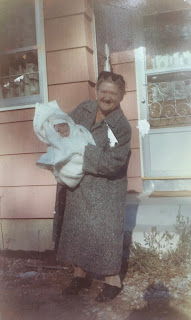My dad was a big guy.
I'm talking the broad-chested, big armed, big bellied kind of working guy. The kind of guy who literally, early in his working life, could heave several hundred pound sides of meat up into the Swifts Premium Meats truck he'd been hired to drive.
Then he got married.
He wanted to be home, not out driving. He wanted to make a good salary in order to build his own home on land given to him and my mom by his mother-in-law, and to adopt some kids.
 |
| My dad and his favorite "things" in the late 1950's: his mother, his wife, and his Chevy. |
So he went to work as a machinist and sat at a work bench day in and day out with a loupe strapped to his forehead and machine oil covering his hands. By the time I came along in 1961 he'd got eczema, got fat, and dreamed of getting out. It took him another 10 years of drafting, research, and scheming about franchises and the great outdoors before he was able to invest his and a bit of money from his mother into the new development of a K.O.A. (Kampgrounds of America) campground in Mystic, CT, 25 miles away.
It was clear that being a factory machinist was making him unhealthy. Like almost everyone in those days, he was a heavy smoker. And the weight he was gaining just felt inexorable to us all.
My mother had a recurring nightmare, one she told me and my brother as little kids at the time, that as he was coming in the back door in the evening after work a murderer -- holding her hostage behind the door -- would shoot him. This was probably a lot more about her own fears than my dad's reality, but the message to her was that my dad was so big that death would not be able to miss him. She feared for his life, that his size would take him.
And it did.
I just had to confront my dad's life and death again, 20 years after he passed from complications of diabetes-caused amputations, in my first clinical shift as a Certified Nursing Assistant (CNA).
I served three older, White male patients during my first shift. They all had diabetes, and all had circulation problems in their legs and feet -- just like my dad.
When I walked into the first room, I could hardly stop staring at those so-familiar legs. If you're a severe diabetic, the excess sugar in your blood stream impedes your immune system while simultaneously causing neuropathy, putting one at greater risk for an all-too common and dangerous bacterial skin infection of the legs known as cellulitis.
This man's legs looked just like my dad's: swollen until they looked hard as newel posts, and a deep bluish red.
I wouldn't be exaggerating if I told you I wanted to cry: for this man, who had already lost a few toes so that his feet functioned in more of a club-like fashion; and for my dad, who died in 2002 after having his second below-knee leg amputation resulting from uncontrolled Type 2 diabetes. Obesity is one of the major factors in the onset of Type 2 diabetes as it causes insulin resistance. And obesity in the U.S. is a systemic social disease -- not a personal one alone.
My next stop was to assist a very obese man with his toileting. Again like my dad, his weight-driven diabetes was creating infections and had made him unable to independently perform some of his key activities of daily living (ADL's in CNA jargon).
My nursing partner and I took care of him that day, as we said, "like a king." The duty nurses loved all these patients: they knew them well. The gentlemen, like my father, were in and out of the hospital regularly, living long term with the impacts of their life choices.
During my father's first hospital stay sometime in the 1990's, when they told him they were unable to heal the open wound on his foot that had been festering for months despite excellent care, he began to throw things at the nurses assigned to him. He was so angry that medicine was unable to fix a problem he knew would ultimately take his life.
But the only one who could have fixed it was him.



























